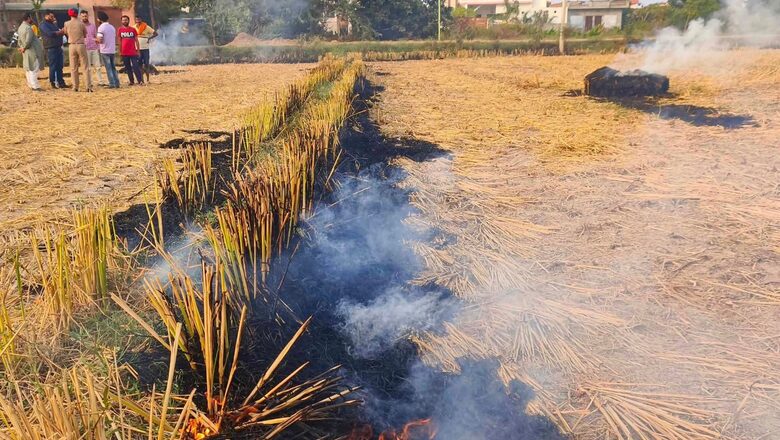
views
Every year in the period between September and November, coinciding with the festival of Diwali, farmers in North India set millions of tonnes of paddy straw on fire turning Delhi’s air toxic. Amid a retreating monsoon, north-westerly winds carrying plumes of smoke from farm fires far away flow slowly towards the Delhi National Capital Region (NCR) where toxic pollutants are trapped in the cold winter weather, forming a ‘gas chamber’.
While road traffic and industrial pollution are year-round sources of the smog—a culmination of stubble burning and changing weather patterns are at the heart of the tragedy that seals New Delhi’s fate. Over 71 million people in Delhi-NCR are exposed for several weeks to severely unhealthy levels of air quality. Millions more are affected in adjoining states of North India. Most residents are known to develop a cough and face irritation in the eyes. More serious patients land up in emergency rooms complaining of respiratory constraints and heart issues.
The crisis has sparked a political blame game between the governments of AAP-ruled Punjab and Delhi on one side and BJP-ruled Haryana and the Centre on the other even as the people of Delhi suffer an urgent health crisis. Instead of treating the crisis as a foremost public health issue, state administrations have struggled to curb the menace with varying success.
A comparison between Punjab and Haryana is rather lopsided. While Haryana has managed to curb 38% of stubble burning incidents, Punjab’s initial gains are rapidly coming undone with farm fires back on the rise in November. While Haryana accounts for only 5% of total fire incidents this season, Punjab accounts for 65%.
Despite having AAP governments in New Delhi and in Punjab, the two states have failed in coordination and taking sweeping action against stubble burning.
Punjab Falls Short
Around 32 lakh hectares is cultivated for paddy in Punjab as compared to Haryana’s 15 lakh hectares, but the state still lags disproportionately behind its neighbour in reducing the menace of farm fires. According to the records provided by the Punjab government, the period between September 15 and November 8, 2023 marked a 30% reduction in farm fire incidents from the same period in 2022 and 45% from 2021.
While Punjab showed a promising reduction in incidents in October, that changed rapidly in the last two weeks. Around 66% of the 22,981 reported incidents of straw burning in Punjab have occurred in the first eight days of November alone.
Punjab has even drawn the ire of the Supreme Court of India. On Tuesday, the Supreme Court pulled up the Punjab government urging the state to stop the fires immediately.
“We want it (stubble burning) stopped. We don’t know how you do it, it’s your job. But it must be stopped. Something has to be done immediately,” the Supreme Court said to the Punjab government. The Supreme Court even endorsed the Centre’s attempts to promote a switch from paddy to alternative crops in Punjab. “The switch over can only occur when the MSP is not granted for paddy but is given to an alternative crop, something which the Central Government in any case is seeking to encourage by growing and utilization of the traditional crops,” it observed.
News18 spoke with Adarsh Pal Vig, Chairman of the Punjab Pollution Control Board, who is hopeful for better days ahead even as he acknowledges that more needs to be done.
“The number of fire incidents are on the decreasing trend from the previous years. Our target is to reduce the incidents by 50% minimum. Initially, we were achieving around 58-59% reduction but the previous few days have put us under 35%. The days ahead are critical,” he told us.
In Punjab, around 8,000 officers have been deployed to tackle the problem of stubble burning, Vig told News18.
“All deputy commissioners are reviewing the situation on the ground. They have been guiding the farmers, making the machines available to them and asking them to go for in-situ management of the residue,” he said while also adding that the state must target 100% reduction or zero stubble burning.
But it is no easy task for officials to get the farmers on board. In Punjab’s Bathinda district, a group of farmers were filmed disobeying the instructions of a farm fire prevention team and even allegedly compelled an officer to join them in igniting a pile of stubble.
Unlike Haryana, governments of Punjab and Delhi recently had dropped the plan to provide cash incentives to farmers for not burning crop residue. This came after the Centre rejected their proposal to bear 60% of the cost. Politicking over this incentive has cost the residents of Delhi, the air they breathe.
Haryana Leads the Way
Haryana’s performance comes in stark contrast with that of Punjab. The state is on a downward trend with 1,605 total reported incidents of stubble burning. It has registered a 38% reduction in farm fire incidents from the previous year. The state is reporting a fall in incidents by almost 64% as compared to the same period in 2021.
Nirmal Kashyap, Senior Environmental Engineer at the Haryana Pollution Control Board, told News18 that “the goal was to have zero active fire locations by next year.”
“The government has taken many good initiatives for the state, starting from incentives for farmers, transportation costs for Gaushalas, additional cash incentives for villages in red and yellow zones and so on,” Kashyap remarked in conversation with News18.
Unlike Punjab, the Haryana government is fully incentivising farmer communities that are not involved in stubble burning. Incentives worth Rs 1,000 per acre for each Panchayat that does not indulge in stubble burning have been offered. An area of almost 11 lakh acres has been registered under this incentive scheme. Fines worth Rs 32.55 lakh have been slapped so far on those continuing the practice.
Almost 50% of Haryana’s paddy are basmati varieties of rice that leave longer bits of straw on harvest which the farmers use as crop fodder instead of burning. In fact, the state government is covering the transportation costs to facilitate the transfer of straw from the farmer to the state’s many Gaushalas (cow sheds).
Another initiative of the Haryana government is a crop diversification drive which has been urging farmers to diversify away from water intensive paddy to alternatives like maize or millets. An incentive of Rs 7,000 per acre of land diversified away from paddy with an alternative crop is being offered to farmers under the Mera Pani Meri Virasat scheme. 71,435 acres of land have been registered under MPMV.
Villages have been divided as green, yellow and red villages. Around 147 have been marked as red as they have more than six active fire locations. This identification system helps officials to efficiently target straw burning hotspots.
The government of Haryana is offering additional incentives of Rs 1,00,000 and Rs 50,000 for panchayats in the red and yellow zones respectively, that do not engage in stubble burning.
Stubble Can ‘Fuel’ India, But Farmers Need to Buy In
While both the state administrations of Punjab and Haryana have tried to lean on innovative solutions, acceptance by farmers has been varied. It has been an up-hill task for officials to convince farmers to embrace new technologies.
Initially, farmers in Punjab were receptive to buying machinery like the ‘happy seeder’ under the Crop Residue Management (CRM) Machinery scheme. However, their demand has dropped since. Despite subsidies for the machines, farmers are still reluctant owing to expensive prices and increased operational costs due to the use of diesel in these machines.
Straw is a good source of biofuel. Farmers who bought balers this season have hit a jackpot selling bales of straw to biomass and boiler plants for lakhs of rupees. Srikanta K Panigrahi, Director General at the Indian Institute of Sustainable Development remarked how pellets made of straw could benefit farmers and fuel the country too.
“Compressed parali could be used as a fuel source in power plants replacing coal and reducing fossil fuel carbon emissions. Pellets have good calorific value and are considered renewable energy sources,” he told News18
In conversation with News18, Vig highlighted the process of pelletisation of paddy straw into pellets that can be used as fuel by thermal power plants. The government of Punjab has been promoting this process among farmers.
The Centre had shown the way forward in how stubble could be put to use in producing ethanol. Indian Oil Corporation’s 2G ethanol plant in Panipat, Haryana can process 2.1 lakh metric tonnes of rice straw annually to make 3 crore litres of ethanol which is then blended with petrol for creating hybrid fuels. Built at a cost Rs 900 crore, the plant was inaugurated by Prime Minister Narendra Modi in August, 2022, and will contribute to the government’s mission to blend petrol with ethanol. It has already close to reaching its 100% processing capacity.
Small entrepreneurs and start-ups have also emerged in the fray to realise the waste-to-wealth potential of straw. Aarushi Mittal, a young entrepreneur from Punjab, was studying textile design in the UK when she started ‘Parali by Aarushi’. Rugs, table mats, fabrics, earrings and other products are crafted out of stubble and so on creating value out of something that would have otherwise been disposed of and burned.
Another business, Hamburg-based BIO-LUTIONS operates in Ramanagara, near Bengaluru, purchasing agricultural waste to create eco-friendly packaging and tableware. Using patented technology, they transform agro-waste into self-binding fibres with water in large machines, resulting in sustainable products that biodegrade in just three months.
Kriya Labs offers a solution to convert 15-20 million tonnes of underutilised rice straw annually into pulp. This pulp serves as a versatile intermediary for various industries, including paper, bioethanol, fabrics, and specialty chemicals. The environmentally friendly process ensures adaptability to different end applications, with pulp quality tailored accordingly.
While rice straw presents various commercial opportunities from fabrics to fuel. Alarmingly raised AQI levels in Delhi-NCR need to be treated as a public health emergency and zero tolerance should be shown towards stubble burning. A concerted and coordinated approach, across political divides, must be taken to avail attractive and profitable options for farmers to repurpose the straw as there is no dearth of green solutions to manage the issue.




















Comments
0 comment